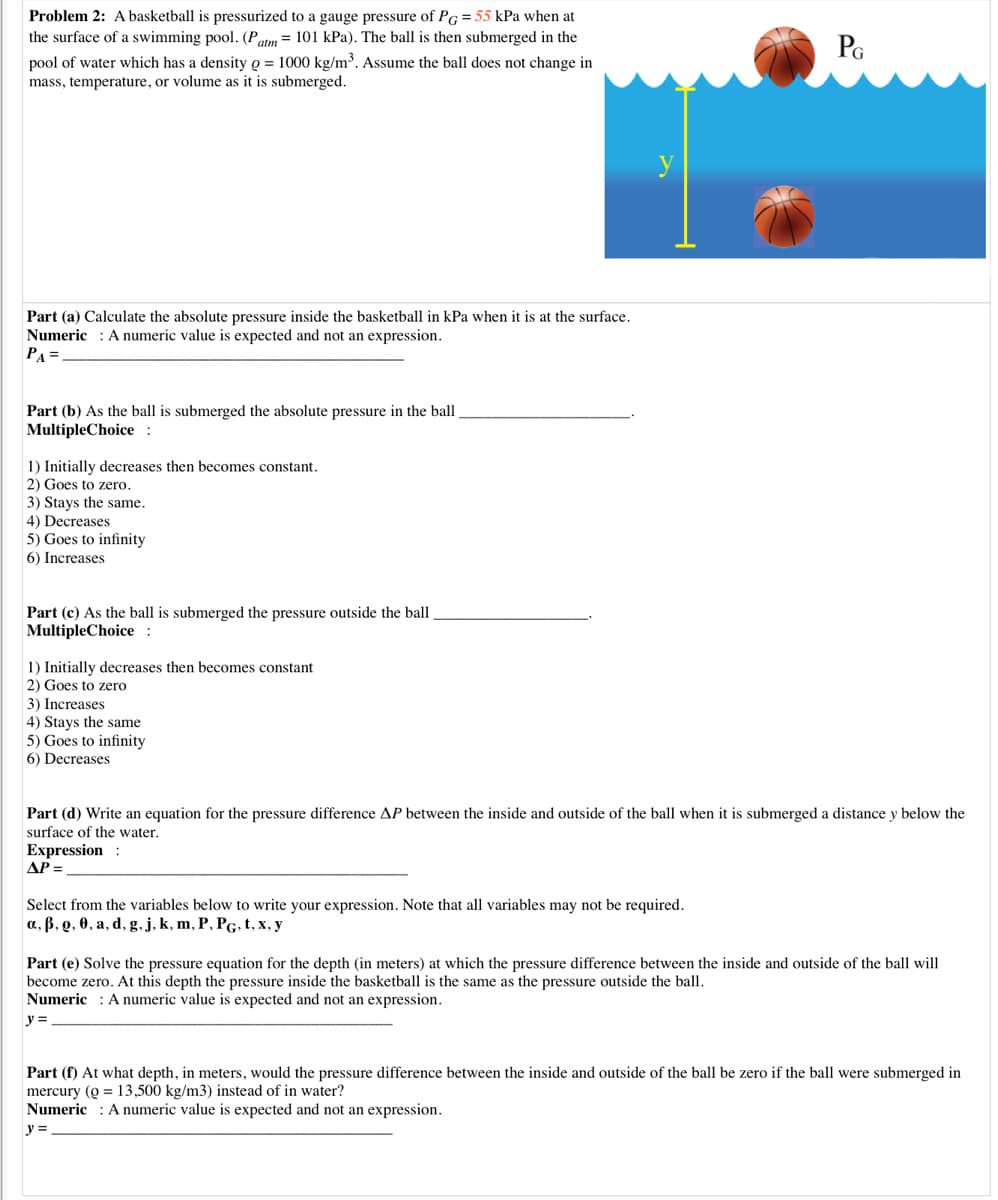Problem 2: A basketball is pressurized to a gauge pressure of PG = 55 kPa when at the surface of a swimming pool. (Patm = 101 kPa). The ball is then submerged in the pool of water which has a density o = 1000 kg/m³. Assume the ball does not change in mass, temperature, or volume as it is submerged. PG y Part (a) Calculate the absolute pressure inside the basketball in kPa when it is at the surface. Numeric : A numeric value is expected and not an expression. PA=. Part (b) As the ball is submerged the absolute pressure in the ball, MultipleChoice : 1) Initially decreases then becomes constant. 2) Goes to zero. 3) Stays the same. 4) Decreases 5) Goes to infinity 6) Increases Part (c) As the ball is submerged the pressure outside the ball MultipleChoice : 1) Initially decreases then becomes constant 2) Goes to zero 3) Increases 4) Stays the same 5) Goes to infinity 6) Decreases Part (d) Write an equation for the pressure difference AP between the inside and outside of the ball when it is submerged a distance y below the
Problem 2: A basketball is pressurized to a gauge pressure of PG = 55 kPa when at the surface of a swimming pool. (Patm = 101 kPa). The ball is then submerged in the pool of water which has a density o = 1000 kg/m³. Assume the ball does not change in mass, temperature, or volume as it is submerged. PG y Part (a) Calculate the absolute pressure inside the basketball in kPa when it is at the surface. Numeric : A numeric value is expected and not an expression. PA=. Part (b) As the ball is submerged the absolute pressure in the ball, MultipleChoice : 1) Initially decreases then becomes constant. 2) Goes to zero. 3) Stays the same. 4) Decreases 5) Goes to infinity 6) Increases Part (c) As the ball is submerged the pressure outside the ball MultipleChoice : 1) Initially decreases then becomes constant 2) Goes to zero 3) Increases 4) Stays the same 5) Goes to infinity 6) Decreases Part (d) Write an equation for the pressure difference AP between the inside and outside of the ball when it is submerged a distance y below the
Chapter2: The Kinetic Theory Of Gases
Section: Chapter Questions
Problem 94CP: An airtight dispenser for drinking water is 25 cm × 10 cm in horizontal dimensions and 20 cm tall....
Related questions
Question
Fluids Q2

Transcribed Image Text:Problem 2: A basketball is pressurized to a gauge pressure of PG = 55 kPa when at
the surface of a swimming pool. (Patm = 101 kPa). The ball is then submerged in the
PG
pool of water which has a density Q = 1000 kg/m³. Assume the ball does not change in
mass, temperature, or volume as it is submerged.
Part (a) Calculate the absolute pressure inside the basketball in kPa when it is at the surface.
Numeric : A numeric value is expected and not an expression.
PA =
Part (b) As the ball is submerged the absolute pressure in the ball.
MultipleChoice :
1) Initially decreases then becomes constant.
2) Goes to zero.
3) Stays the same.
4) Decreases
5) Goes to infinity
6) Increases
Part (c) As the ball is submerged the pressure outside the ball,
MultipleChoice :
1) Initially decreases then becomes constant
2) Goes to zero
3) Increases
4) Stays the same
5) Goes to infinity
6) Decreases
Part (d) Write an equation for the pressure difference AP between the inside and outside of the ball when it is submerged a distance y below the
surface of the water.
Expression :
AP =
Select from the variables below to write your expression. Note that all variables may not be required.
а, В. о, Ө, а, d, g.j. k, m, P, PG.t,x, у
Part (e) Solve the pressure equation for the depth (in meters) at which the pressure difference between the inside and outside of the ball will
become zero. At this depth the pressure inside the basketball is the same as the pressure outside the ball.
Numeric : A numeric value is expected and not an expression.
y =
Part (f) At what depth, in meters, would the pressure difference between the inside and outside of the ball be zero if the ball were submerged in
mercury (Q = 13,500 kg/m3) instead of in water?
Numeric : A numeric value is expected and not an expression.
Expert Solution
This question has been solved!
Explore an expertly crafted, step-by-step solution for a thorough understanding of key concepts.
This is a popular solution!
Trending now
This is a popular solution!
Step by step
Solved in 2 steps with 2 images

Knowledge Booster
Learn more about
Need a deep-dive on the concept behind this application? Look no further. Learn more about this topic, physics and related others by exploring similar questions and additional content below.Recommended textbooks for you

